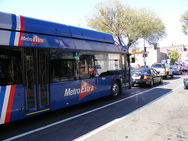MetroExtra could come to Columbia Pike in Montgomery County

Photo by dan reed! on Flickr.
Columbia Pike between Silver Spring and Burtonsville is one of the region’s busiest bus corridors, but is prone to delays and crowding. Metro is studying improvements that could make the service faster and more reliable, making it a trial of sorts as Montgomery County considers Bus Rapid Transit for that corridor.
The Z Metrobus lines, made up of the Z2, Z6, Z8, Z9, Z11, Z13, and Z29, travel between Silver Spring, Burtonsville, and Laurel along Columbia Pike and Colesville Road, also known as Route 29. It is the second-busiest line in Maryland, though 85% of the ridership is in a short segment between the Silver Spring Metro and White Oak.
Metro planners and their consultants presented potential solutions at two public meetings this month, including, additional evening and weekend service and a new, limited-stop MetroExtra route along Route 29. They plan to release their recommendations this November.
Limited-stop service a stepping stone to BRT
Common issues with the Z line include bus bunching and crowded buses, especially outside of rush hour when buses are less frequent. Riders say that some stops are unsafe because of traffic or poor lighting, and that entire neighborhoods are left without service on the weekends, when the Z6 route (which carries over a third of the line’s riders) does not run.
As with Metro’s other bus corridor studies, planners are considering introducing MetroExtra service along Route 29, with ten stops roughly every mile from the Silver Spring Metro to Castle Boulevard, an area known for growing poverty and long commutes.
Buses would run every 15 minutes in both directions during rush hour. To free up resources for the new route, Metro would consolidate two existing express lines, the Z9 and Z11. Initially, the route would only run as far as Stewart Lane in White Oak, with an extension to come later as funding permits.
Enhanced limited-stop service will be a welcome change for residents who currently face a 40-plus minute trip just to reach the Metro station. But it could also provide an interesting test of how a Bus Rapid Transit line on Route 29 might work. It’s one of 10 corridors in the county’s plan, and is slated to be one of the first to get built, along with Route 355. The county’s plans include dedicated lanes along the corridor, which would speed up buses by getting them out of traffic.
County officials have long promised that BRT service will add to and not take away from existing Metrobus and Ride On service. Interestingly, proposed MetroExtra service does not include stops in Montgomery’s BRT plan at Franklin Avenue and Fairland Road, but adds others in White Oak and Briggs Chaney, where ridership is higher.
More frequent service, new lines
The project team also addressed crowding on the Z6 and Z8 routes, which are local services. The proposed remedies included adding short trips on both lines between Silver Spring and White Oak, and restoring weekend service on the Z6 line.
One of the proposals involved running the Z6 once per hour on weekends, which violates Montgomery County’s requirement that a bus must run every 30 minutes, or not at all. Others had it and the Z8 running more frequently, which would be more expensive.
Metro planners are also exploring a new route, the Z10, to connect the Briggs Chaney park and ride with Laurel, addressing rider concerns that they had a hard time getting to shopping areas in Laurel.
Another idea was that the Z2 bus, which runs between Olney and Silver Spring via New Hampshire Avenue, run additional mid-day trips from Olney to White Oak, where riders could switch to other buses. Ridership has dwindled on this line, which carries an average of less than 10 riders per trip north of White Oak.
Minor recommendations included updates to bus stops such as more shelters and signs, schedule adjustments, and placing supervisors at various places along the route to reduce bus bunching.
Can these proposals get funding?
Bus Rapid Transit is a significant part of the White Oak Science Gateway plan, which envisions a town center around the Food and Drug Administration campus there. The plan requires the county to find a funding source for BRT lines on Route 29 and New Hampshire Avenue before most of the development can go forward.
But it’s unclear where funding for BRT, or even a MetroExtra line, would come from. While WMATA recommended MetroExtra service on the Q and Y lines in Montgomery County, the Maryland legislature has already denied requests to fund them.
Will both of these services be implemented at roughly the same time? Will either one be implemented at all, or will one service try to be all things for all people and fulfill the aims of BRT and the local enhancements Metro is considering? It all depends on how they’re funded. The Route 29 corridor is one that Montgomery County is focusing on for economic growth, but it may also be a bellwether for what our transit future will look like in the decades to come.

